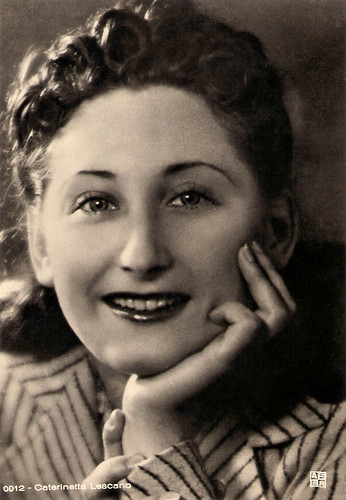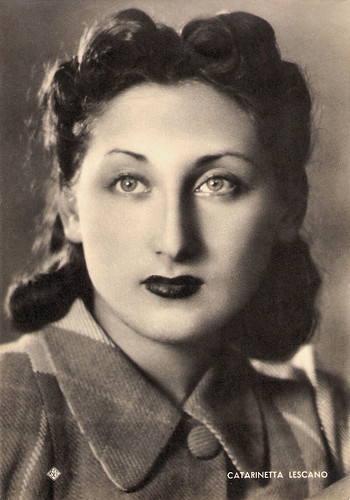
Caterinetta Lescano. Italian postcard by Aser, Roma, no. N 0012.
The Sunday Sisters
Trio Lescano was a trio of Dutch sisters singing Italian swing: Alexandra (1910-1987), Judith (several sources say Judik) (1913-2007), and Kitty Leschan (1919-1965), whose names were Italianized into Alessandra, Giuditta and Caterinetta (Caterina) Lescano.
The three girls were born in Gouda (Alexandra) and The Hague. Their parents were August Alexander Leschan, a Budapest-born contortionist, and Eva de Leeuw (1892-1985), a Dutch Jewish operetta singer. They grew up in the Netherlands, where two of them worked with their mother as acrobats under the name 'The Sunday Sisters'.
They arrived in Italy in 1935 and started to dance in a variety show. They were discovered by Carlo Prato, artistic director of the Turin department of the EIAR radio (later the RAI). Soon they became known as background vocalists under the name of Trio Lescano. They made their first record in 1936 for Parlophone, ‘Guarany Guarana’. The next year they became part of the popular Cetra Orchestra, directed by Pippo Barzizza. In 1938 they had their breakthrough with the song ‘E arrivato l’Ambasciatore’.
That year, they also made their film debut with an appearance in the drama L'argine/The Dyke (Corrado D'Errico, 1938) starring Luisa Ferida and Gino Cervi. In 1942, they also appeared in Pazzo d'amore/Crazy Love (Giacomo Gentilomo, 1942) starring Renato Rascel.
The Trio Lescano's style was based on sophisticated vocal virtuosity - a technique called ‘vocalese’ - on swing and jazz harmonisations. Their greatest hits include ‘Signorine Grandi Firme’, ‘Maramao perché sei morto’, ‘Ma le gambe’, ‘Pippo non lo sa’, ‘Camminando sotto la pioggia’, ‘La famiglia canterina’, ‘C’è un’orchestra sincopata’, Il pinguino innamorato’, and 'Ciribiribin'. And of course 'Tulipan', a cover of 'Tulip Time' by the Andrews Sisters, which sold more than 350.000 records in Italy.

Caterinetta Lescano. Italian postcard by Aser, Roma, no. N 0019. Photo: E.I.A.R. / Romeo.

Pippo Barzizza. Italian postcard by ASER.
The three graces of the microphone
In 1941 the Lescano sisters became Italian citizens. This made big news in the Italian papers, who had invented for them such definitions as ‘the three graces of the microphone’, ‘the century's sensation’ and 'the sisters who materialize the mystery of the heavenly trinity’.
Even Benito Mussolini, passing by their balcony one day, reportedly recognised them and stopped to greet them. But just a year later, their golden period ended. In 1942, the radio bosses sent the three sisters away because their mother was Jewish. A year later North Italy was occupied by the Germans. According to Allessandra, the Lescano sisters were arrested on suspicion of espionage. The accusation was that their songs contained encoded messages for the enemy.
Immediately after the war, their comeback was not very successful so they decided to try their luck elsewhere. Caterinetta left the trio and tried a solo career. In 1947, the two other sisters left for Argentina, where they toured for several years. Caterinetta was replaced by the Italian singer Maria Bria. Their artistic career in Latin America continued until the mid-fifties. Then, the ladies took up ordinary jobs and split up.
They were rediscovered after the Dutch documentary film Tulip Time: The Rise and Fall of the Trio Lescano (Tonino Boniotti, Marco De Stefanis, 2008), which premiered at the San Francisco Jewish Film Festival 2008.
In 2010, Italian television produced the mini-series Le Ragazze dello Swing/The Swing Girls (Maurizio Zaccaro, 2010) based on the Lescano story. It featured Hungarian actress Andrea Osvárt as Alessandra and Dutch actresses Lotte Verbeek as Giuditta and Elise Schaap as Caterinetta. The mother of the Lescano girls was played by Sylvia Kristel, in her final role. The actresses did not sing themselves, the songs were performed by the group The Blue Dolls. Outside Italy, the series was released on DVD.
The Blue Dolls sing Maramao Perchè Sei Morto?. Source: The Blue Dolls (YouTube).
Sources: Wikipedia (English and Italian) and IMDb.
This post was last updated on 18 March 2025.
I will have to check out that series if it becomes available here. It sounds wonderful.
ReplyDelete